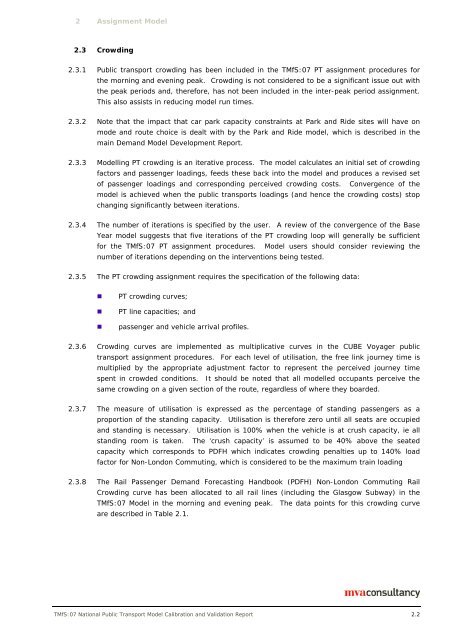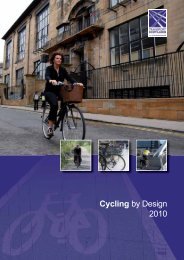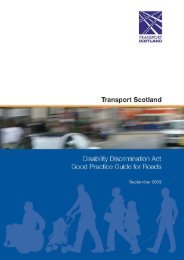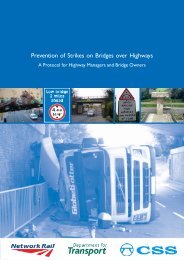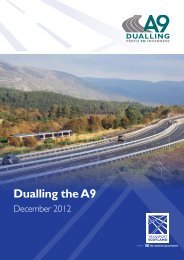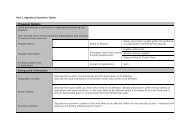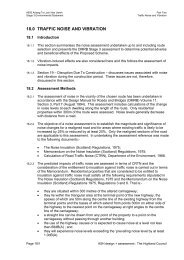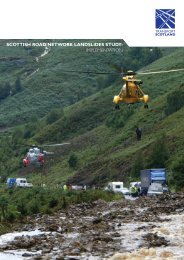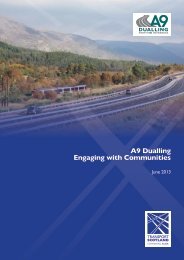Public Transport Model Calibration and Validation Report
Public Transport Model Calibration and Validation Report
Public Transport Model Calibration and Validation Report
You also want an ePaper? Increase the reach of your titles
YUMPU automatically turns print PDFs into web optimized ePapers that Google loves.
2 Assignment <strong>Model</strong><br />
2.3 Crowding<br />
2.3.1 <strong>Public</strong> transport crowding has been included in the TMfS:07 PT assignment procedures for<br />
the morning <strong>and</strong> evening peak. Crowding is not considered to be a significant issue out with<br />
the peak periods <strong>and</strong>, therefore, has not been included in the inter-peak period assignment.<br />
This also assists in reducing model run times.<br />
2.3.2 Note that the impact that car park capacity constraints at Park <strong>and</strong> Ride sites will have on<br />
mode <strong>and</strong> route choice is dealt with by the Park <strong>and</strong> Ride model, which is described in the<br />
main Dem<strong>and</strong> <strong>Model</strong> Development <strong>Report</strong>.<br />
2.3.3 <strong>Model</strong>ling PT crowding is an iterative process. The model calculates an initial set of crowding<br />
factors <strong>and</strong> passenger loadings, feeds these back into the model <strong>and</strong> produces a revised set<br />
of passenger loadings <strong>and</strong> corresponding perceived crowding costs. Convergence of the<br />
model is achieved when the public transports loadings (<strong>and</strong> hence the crowding costs) stop<br />
changing significantly between iterations.<br />
2.3.4 The number of iterations is specified by the user. A review of the convergence of the Base<br />
Year model suggests that five iterations of the PT crowding loop will generally be sufficient<br />
for the TMfS:07 PT assignment procedures. <strong>Model</strong> users should consider reviewing the<br />
number of iterations depending on the interventions being tested.<br />
2.3.5 The PT crowding assignment requires the specification of the following data:<br />
• PT crowding curves;<br />
• PT line capacities; <strong>and</strong><br />
• passenger <strong>and</strong> vehicle arrival profiles.<br />
2.3.6 Crowding curves are implemented as multiplicative curves in the CUBE Voyager public<br />
transport assignment procedures. For each level of utilisation, the free link journey time is<br />
multiplied by the appropriate adjustment factor to represent the perceived journey time<br />
spent in crowded conditions. It should be noted that all modelled occupants perceive the<br />
same crowding on a given section of the route, regardless of where they boarded.<br />
2.3.7 The measure of utilisation is expressed as the percentage of st<strong>and</strong>ing passengers as a<br />
proportion of the st<strong>and</strong>ing capacity. Utilisation is therefore zero until all seats are occupied<br />
<strong>and</strong> st<strong>and</strong>ing is necessary. Utilisation is 100% when the vehicle is at crush capacity, ie all<br />
st<strong>and</strong>ing room is taken. The ‘crush capacity’ is assumed to be 40% above the seated<br />
capacity which corresponds to PDFH which indicates crowding penalties up to 140% load<br />
factor for Non-London Commuting, which is considered to be the maximum train loading<br />
2.3.8 The Rail Passenger Dem<strong>and</strong> Forecasting H<strong>and</strong>book (PDFH) Non-London Commuting Rail<br />
Crowding curve has been allocated to all rail lines (including the Glasgow Subway) in the<br />
TMfS:07 <strong>Model</strong> in the morning <strong>and</strong> evening peak. The data points for this crowding curve<br />
are described in Table 2.1.<br />
TMfS:07 National <strong>Public</strong> <strong>Transport</strong> <strong>Model</strong> <strong>Calibration</strong> <strong>and</strong> <strong>Validation</strong> <strong>Report</strong> 2.2


